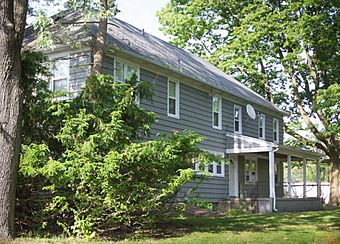Booth-Dunham Estate facts for kids
The Booth-Dunham Estate is a historic home located at 6059 South Ninth Street in Texas Charter Township, Michigan. It's near the city of Kalamazoo, Michigan. This special property was added to the National Register of Historic Places in 1998. This means it's recognized as an important part of history.
Contents
History of the Booth-Dunham Estate
Early Owners and Builders
In 1836, a couple named DeForest and Catharine Maria Manice bought over 1000 acres of land. They lived in Hempstead, New York, and bought this land in Kalamazoo County as an investment.
A few years later, in 1841, the Manices allowed Catharine's brother, William Booth, to settle on some of this land. William and his wife Abigail moved there from Stratford, Connecticut. They brought their two sons with them.
The Booth family farmed the land for about 20 years. William Booth also worked in local government. During this time, he built the first part of the farmhouse that stands today.
The Dunham Family Takes Over
William Booth passed away in 1864. Two years later, in 1866, Thomas P. Dunham bought the farm. Thomas was born in Junius, New York, in 1822.
Before coming to Kalamazoo County in 1859, Thomas worked as a grocer in Chicago. He was also a sugar broker in New Orleans. He moved to the area with his wife, Emily Dunham.
Thomas Dunham was very involved in his community. He served as the Highway Commissioner. He was also a director at the local school. Around 1875, the Dunhams made the house bigger by adding more rooms.
Passing Through Generations
Thomas Dunham died in 1895. Before he passed, he gave the farm to his oldest son, Charles. Charles ran the farm until he died in 1909.
After Charles, the farm went to Thomas's second son, Edgar. The Dunham family continued to operate the farm for many years. The last of Thomas's children died in 1946.
In 1952, the Sprau family bought the farm. Later, in 1967, they sold most of the land. This land was bought by Kalamazoo Valley Community College for their new campus.
What the Estate Looks Like
The Booth-Dunham Estate sits on 22 acres of land. It includes the main farmhouse, a large barn, a tool shed, a wood shed, and a wellhouse.
The Farmhouse
The house is a 1-1/2 story building. It has a T-shape and a side-gable roof. It's built in the Greek Revival style. This style was popular in the 1800s. It often features simple, balanced designs.
The house has a strong timber frame and a foundation made of fieldstone. It's covered with clapboard siding. The roof is low-pitched, which is typical for Greek Revival homes. The windows are placed in a very balanced way.
The front of the house is almost perfectly symmetrical. On the first floor, there's a front door in the middle. On each side of the door, there are two windows with shutters. The second floor has three windows. A porch with a shed roof runs across the front of the house. Simple columns hold up the porch.
Other Buildings on the Estate
The barn is very large, measuring 30 feet wide and 120 feet long. It has a timber frame and a side-gable roof. It's covered with vertical wooden siding. This barn was probably built around the same time as the house, about 1840.
The toolshed is a single-story building. It's 60 feet long and 16 feet wide. This shed was likely built around the 1920s.
The woodshed is a single-story building with a front-gable roof. It's about 20 feet long and 16 feet wide.
The wellhouse is a small building with a pyramid-shaped roof. It's made of concrete blocks and measures ten feet by ten feet. It covers a six-foot-deep stone-lined well pit. This building also likely dates from the 1920s.


